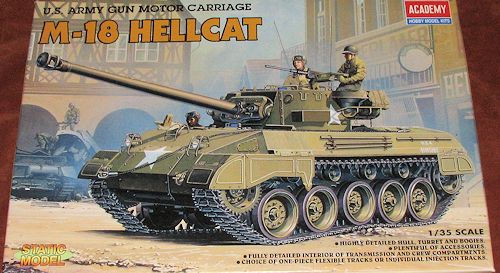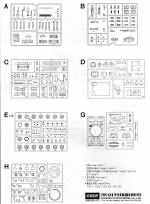
| KIT #: | 1375 |
| PRICE: | $Just do not remember |
| DECALS: | Two options |
| REVIEWER: | Scott Van Aken |
| NOTES: |

| HISTORY |
The M18 Hellcat was an American tank destroyer of World War II. Armed with a 76 mm cannon, the vehicle was the fastest tracked, armored fighting vehicle during World War II with a top speed up to 60 mph (92kph), and Buick nicknamed it the Hellcat. The speed was attained by keeping armor to a minimum, no more than 1" thick. Hellcat crews took advantage of the vehicle's speed to minimize the enemy's ability to pierce its thin armor.
The M18's new design incorporated several innovative maintenance features. The Wright R-975 engine was mounted on steel rollers that allowed maintenance crews to disconnect it easily from the transmission, roll it out onto the lowered engine rear cover, service it, and then reconnect it to the transmission. The transmission could also easily be removed and rolled out onto a front deck plate to facilitate quick inspection and repairs.
In contrast to the M10 tank destroyer, which used the chassis of the M4 Sherman, the M18 Hellcat was designed from the start to be a fast tank destroyer. As a result it was smaller, lighter, and significantly faster, but carried the same gun as the Sherman 76 mm models. The M18 carried a five-man crew as well as 45 rounds of main gun ammunition, and an M2 Browning machine gun on a flexible ring mount for use against aircraft and infantry.
The main disadvantages of the M18 were its very light armor, and the inconsistent performance of its 76 mm gun against the frontal armor of later German designs such as the Tiger and Panther. The open-topped turret — a characteristic which it shared with nearly all fully tracked American tank destroyers — left the crew exposed to snipers, grenades, and shell fragments. The doctrinal priority of high speed at the cost of armor protection thus led to a relatively unbalanced design. The problem of the main gun performance was remedied with High Velocity Armor Piercing (HVAP) ammunition late in the war, which allowed the 76 mm gun to achieve greater frontal armor penetration, but this was never available in quantity.
Production started in May 1943 and finished in October 1944, when the war was nearing its end. 2,507 had been produced by that time, at a unit cost of $57,500. Though all tank destroyer units were disbanded by the U.S. after the war, surplus M18s continued to see limited service.
| THE KIT |
 This
is an older Academy kit and is molded in a very dark green plastic that is
nearly black. Thanks to its open top, the kit includes a fairly nice interior
that while not up to today's standards, is nicely detailed. It includes a full
transmission as well as a driver's seat. On the underside of the upper hull
piece are driver's controls for both sides. The lower hull is open in the back
and takes a plate with the usual fittings. All the other interior bits,
including a nicely done floor will fit inside the lower hull section. I should
mention that the instructions do give generic color information for all the
interior and exterior bits.
This
is an older Academy kit and is molded in a very dark green plastic that is
nearly black. Thanks to its open top, the kit includes a fairly nice interior
that while not up to today's standards, is nicely detailed. It includes a full
transmission as well as a driver's seat. On the underside of the upper hull
piece are driver's controls for both sides. The lower hull is open in the back
and takes a plate with the usual fittings. All the other interior bits,
including a nicely done floor will fit inside the lower hull section. I should
mention that the instructions do give generic color information for all the
interior and exterior bits.
Suspension is nicely done with the arms plugging into receptacles already molded into the lower hull. There are also two-piece return rollers. The main road wheel pairs trap a poly cap so that one can easily install them on the suspension bits. This also applies to the drive sprocket and idler gear. Academy provides two types of track. One is the 'rubber band' vinyl track that one heats with a screwdriver and the other is link and length with the separate links going over the drive sprocket and idler as well as the first road wheels.
For the upper hull we have the usual lights, guards, and various tools. The hatches for the driver and co-driver can be posed open and there is interior detail to see as mentioned earlier. The turret is split in two halves and includes things like radios and ammo boxes as well as the gun breech. The barrel is in two halves and you have a choice of a muzzle brake or plain end. There are two different mantlets provided, one with a canvas cover. A .50 cal machine gun is included to attach to a ring on the open turret. The kit also comes with a variety of ammo boxes, shells, towing cables and jerry cans.
Instructions are well done with info in both Korean and English. Markings are provided for two vehicles in late 1944. Both are pretty much the same with one having a star in circle on the very front as the only difference between the two. No unit information is provided. The small decal sheet looks to be well done and is not shown as white markings on a near white background makes it difficult to scan.
| CONCLUSIONS |
I bought this kit many years ago and as such do not recall what I paid for it nor why I bought it aside from the fact that I thought it looked cool. I had at one time thought to do a collection of GMCs, but that has since fallen by the wayside! It looks like a very nice kit and may well be one of the few kits of this vehicle that has been done.
| REFERENCES |
http://en.wikipedia.org/wiki/M18_Hellcat
December 2013
Thanks to your editor for the preview kit.
If you would like your product reviewed fairly and fairly quickly, please contact the editor or see other details in the Note to Contributors.